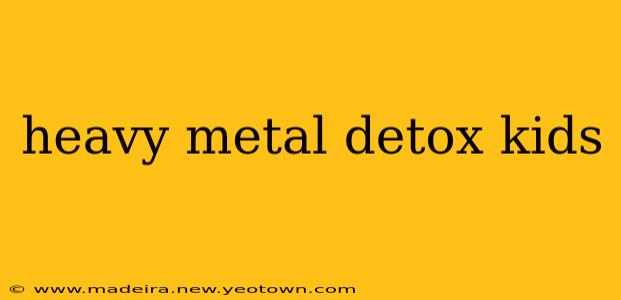The innocence of childhood should be filled with laughter, learning, and carefree adventures, not the silent threat of heavy metal toxicity. As a parent, ensuring your child's well-being is paramount, and that includes protecting them from environmental toxins that can accumulate in their tiny bodies. Heavy metals, such as lead, mercury, cadmium, and arsenic, can silently infiltrate our lives through various sources, posing significant health risks to developing children. This comprehensive guide explores the crucial aspects of heavy metal detox for kids, offering insights and actionable steps for parents concerned about their children's exposure.
What are Heavy Metals and Why are They Dangerous for Kids?
Heavy metals are naturally occurring elements with high densities. While some trace amounts are essential for bodily functions, excessive exposure can be incredibly harmful, especially to children. Their developing bodies are more vulnerable to the toxic effects of heavy metals, leading to a range of serious health problems. Think of it like this: a tiny seedling is much more susceptible to damage from a weed killer than a mature oak tree.
Why are children more at risk?
- Faster Absorption: Children absorb heavy metals more readily than adults.
- Developing Systems: Their still-developing nervous, immune, and endocrine systems are highly sensitive to heavy metal toxicity.
- Higher Exposure Potential: Children often put things in their mouths, increasing their chance of ingesting heavy metals found in paint chips, dust, or contaminated soil.
What are the Common Sources of Heavy Metal Exposure in Children?
Understanding where these metals lurk is the first step towards prevention.
Lead:
- Old Paint: Lead-based paint was common in homes built before 1978. Chipping paint is a major concern.
- Contaminated Soil: Industrial areas and older homes may have lead-contaminated soil.
- Certain Toys and Jewelry: Some imported toys and jewelry contain lead.
Mercury:
- Fish Consumption: Certain types of fish, like tuna and swordfish, can contain high levels of mercury.
- Dental Fillings (amalgam): Although less common now, older amalgam fillings can release small amounts of mercury.
Cadmium:
- Cigarette Smoke: Secondhand smoke exposes children to cadmium.
- Contaminated Food and Water: Industrial pollution can contaminate food and water sources.
Arsenic:
- Contaminated Water: Well water in some areas can contain arsenic.
- Certain Foods: Rice and rice-based products can contain small amounts of arsenic.
How Can I Tell if My Child Has Heavy Metal Toxicity?
Unfortunately, there isn't one single test that definitively proves heavy metal poisoning. Symptoms can be subtle and mimic other illnesses. However, watch for these potential signs:
- Developmental Delays: Speech, motor skill, or cognitive delays.
- Behavioral Problems: Hyperactivity, irritability, aggression, or learning difficulties.
- Gastrointestinal Issues: Nausea, vomiting, diarrhea, or abdominal pain.
- Neurological Symptoms: Headaches, tremors, numbness, or weakness.
If you suspect your child has been exposed to heavy metals, it's crucial to consult a healthcare professional immediately. They can conduct tests to assess their exposure levels and recommend appropriate interventions.
What are the Treatment Options for Heavy Metal Toxicity in Children?
Treatment depends on the specific metal, the level of exposure, and the child's individual health. A doctor might recommend:
- Chelation Therapy: This involves using medications to bind to heavy metals and remove them from the body. It’s crucial to consult a qualified doctor who is well-versed in chelation therapy for children, as it's not without potential side effects.
- Dietary Changes: A balanced diet rich in fruits, vegetables, and antioxidants can support the body's natural detoxification processes.
How Can I Protect My Child from Heavy Metal Exposure?
Prevention is always the best approach:
- Test Your Home for Lead: If you live in an older home, get it tested for lead paint and soil contamination.
- Choose Low-Mercury Fish: Opt for fish lower in mercury, such as salmon or cod.
- Avoid Exposure to Cigarette Smoke: Ensure your home and surroundings are smoke-free.
- Wash Hands Frequently: Regular handwashing helps prevent the ingestion of heavy metals.
What Supplements Can Support Heavy Metal Detoxification in Kids? (A Doctor's Guidance is Essential)
While some supplements are touted for their detoxifying properties, it's crucial to consult a pediatrician or a qualified healthcare professional before giving your child any supplements. They can assess your child's individual needs and determine if any supplements are safe and appropriate. Some commonly mentioned supplements include those containing chlorella, cilantro, and zeolite; however, more research is needed to fully understand their effectiveness and safety in children.
Heavy metal detoxification in children is a complex issue requiring a careful and individualized approach. Remember, this information is for educational purposes only and should not be considered medical advice. Always consult with your pediatrician or a qualified healthcare professional before making any decisions regarding your child's health. Early intervention and a proactive approach to prevention are key to ensuring your child's long-term health and well-being.

